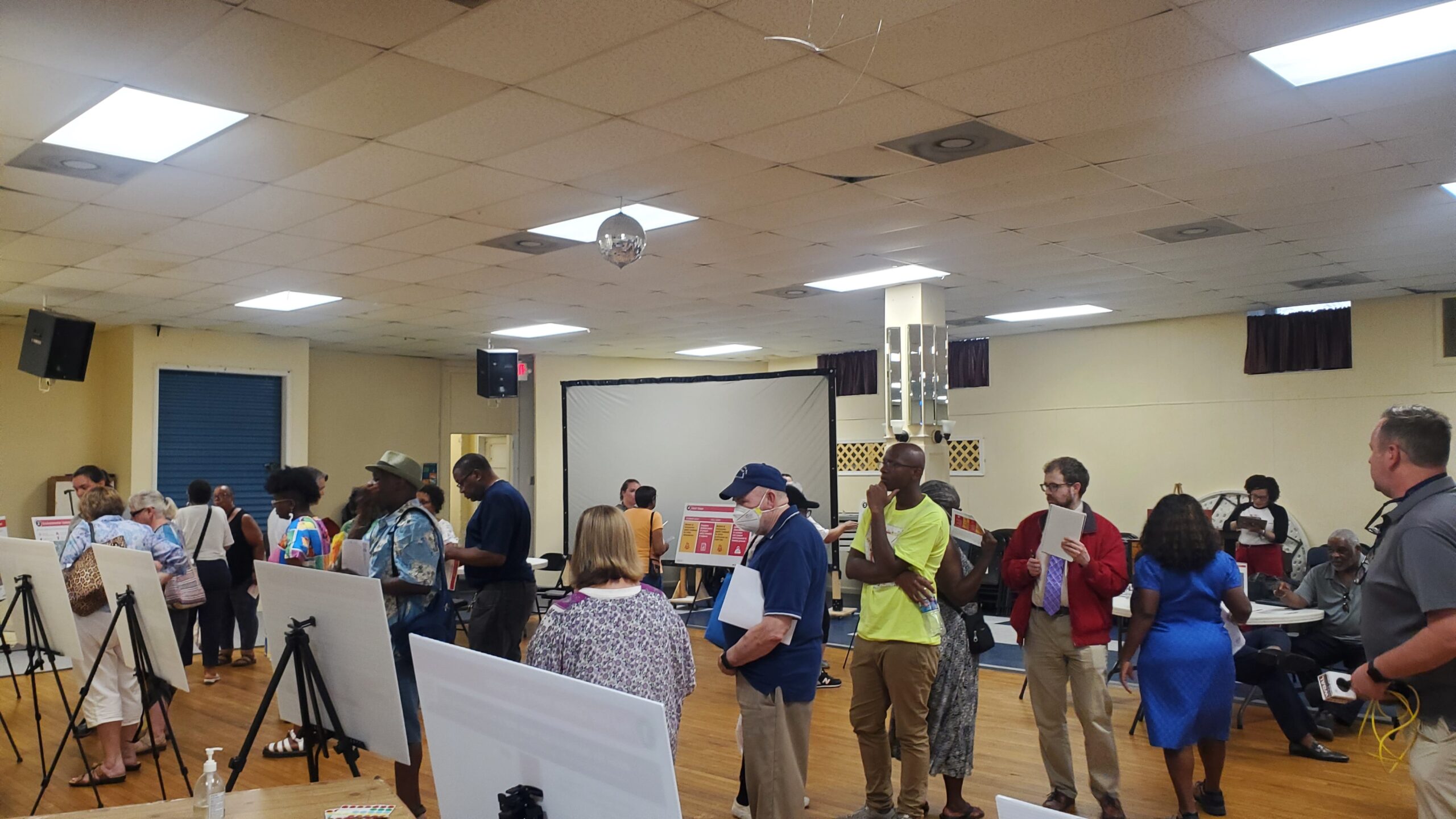
Frequently Asked Questions about the Red Line
Project
The Baltimore Red Line (Red Line) will be a high-frequency, high-capacity light rail transit (LRT) line that will run through downtown Baltimore and fill a critical gap in east-west transit service between the Bayview and Woodlawn communities. For more information on the history of the project, visit the “Background” section of the website: redlinemaryland.com.
The Red Line will primarily operate on a dedicated right-of-way (ROW) separate from traffic and pedestrian/bicycle infrastructure. The Red Line will provide a vital connection between key employment hubs along the west end of the alignment in Baltimore County (e.g., Social Security Administration and Centers for Medicare and Medicaid), downtown Baltimore, and the eastern end of the alignment near Johns Hopkins Bayview.
The Red Line is an investment in Baltimore residents’ access to education, employment, healthcare, recreation, and entertainment. The project builds upon over a decade of technical work, environmental analysis, and community engagement.
The Red Line is currently in the planning phase. The Red Line team is analyzing alternatives and alignments to determine a locally preferred alternative that will move forward into design and engineering.
LRT is a form of public transportation that uses electric-powered trains to carry passengers in urban areas with mixed traffic environments. LRT systems are a modern version of streetcars, but they can carry more passengers, travel faster, and cover longer distances.
The selection of LRT as the preferred mode of transportation was based on technical analysis of considerations including access, travel time, connections, reliability, and ridership, in addition to consideration of the line’s cost-effectiveness as well as strong input from the public expressing a preference for LRT.
MTA anticipates and is planning for the Red Line to run every seven minutes during peak times and every 10 minutes during off-peak times. The service will operate from approximately 5 a.m. to 2 a.m. on weekdays. Note: Operation times are subject to change as planning and operational elements evolve.
The cost of fare and the fare payment system of the Red Line will be consistent with the rest of the MTA local system. The one-way local full adult fare as of 2024 is $2.00.
Funding
At the state level, the Red Line project is currently funded through the design phase. MTA anticipates a combination of local, state, and federal funds will be used to fund construction of the Red Line. We are identifying and evaluating a broad range of options to finance and deliver the project.
Benefits
The Red Line will improve transit efficiency, increase access to work and activity centers, provide connections to existing transit and other transportation modes, offer more commuter choices, and support economic development and community revitalization.
The Red Line will create numerous jobs from construction and bolster support for new and existing businesses along the corridor. According to a study recently conducted by the Greater Washington Partnership on the economic development potential of the Red Line, the Baltimore region would benefit from the creation of thousands of new jobs – as many as 16,000 temporary and 1,650 permanent – and billions of dollars in additional economic output.
The meaningful connections that the Red Line makes to existing transit will be key to creating a more comprehensive transit network. All alignments under consideration will offer direct transfer opportunities to the Maryland Area Rail Commuter (MARC) train at West Baltimore and a proposed East Baltimore MARC station near the Bayview Campus. A connection to the existing Central LRT will be available in downtown Baltimore near the Convention Center. Connections to Metro Subway will vary by alignment and may include a few blocks distance to transfer from the Red Line to the Metro Subway. These connections provide valuable regional connectivity to places like Washington, D.C. via MARC Train, Baltimore/Washington International Thurgood Marshall Airport (BWI) and Baltimore Penn Station. Additionally, there will be ample connections to local and regional bus routes along the line.
The American Public Transportation Association’s (APTA) most recent Transit Savings report shows that individuals who ride on public transportation instead of driving can save more than $13,000 a year, or $1,100 a month, because of significant increases in auto costs and gasoline prices.
For reference, a 31-day MTA fare pass for core service currently costs $77. Annual expense for transit on core service is $924.
Common Concerns
Part of the planning process is to determine the anticipated impacts of the Red Line along the rail corridor, including property that would be needed to implement the project. The Red Line project team will make every effort to avoid any involuntary residential displacements along the 14-mile corridor. The project team will continue to work with the communities along the corridor about the ROW needs as the project progresses.
Because light rail vehicles can carry more people than buses or cars, the Red Line has the potential to improve transit times in a heavily congested corridor. This new rapid transit line will be a first for this critical east-west corridor. Between 28,000 and 35,000 people are expected to ride the Red Line each day, reducing the need for personal vehicles, and decreasing CO2 emissions.
MTA’s transit system has more than 300,000 daily trips on its Metro Subway, Light Rail, MARC train, and local bus systems. Many of MTA’s top ridership bus routes travel along the proposed Red Line corridor and increasing capacity in these corridors is needed. Investing in our high-ridership corridors with premium transit builds upon the system’s strengths and provides our riders with the excellent service they need and deserve.
Much like how local and state taxes support public goods like schools, roads, and emergency services that serve the entire community, public transit benefits everyone, even those who never ride it. A strong transit system connects people to jobs and services, reduces traffic congestion for drivers, and improves air quality by cutting vehicle emissions. It also provides equitable access to opportunities for those who can’t drive, fostering a more inclusive and thriving community – and economy. Even those who do not live along the route benefit from the regional connectivity and economic vitality that transit creates. Consequently, investing in transit is an investment in our shared prosperity, just like other public infrastructure upon which we all rely.
MTA has consistently ranked as one of the safest transit systems among the top 13 transit agencies in the country for nearly a decade. The number of violent crimes within Metro Subway stations specifically has remained low over the past five years.
MTA Police have strong, collaborative relationships with our partner law enforcement agencies and have agreements in place to work together in areas such as community checks, incident response, and investigations.
Transit provides critical connections and access to jobs, education, healthcare, and other vital services. For many residents, it is a lifeline. Metro Subway, LRT and local Bus are part of the greater Baltimore community, and all segments of the community need to work together to reduce crime.
MTA is advancing planning and design for major modernization of the existing LRT system. Along with new, modern, low-floor vehicles that will improve access for all riders, the existing station platforms will be modified to provide seamless step free boarding. Additionally, a new signal system will improve efficiency and increase reliability. The Red Line team is also exploring interoperability between the Red Line and the existing LRT.
Our jurisdictional partners are actively working to support policy that encourages Transit-Oriented Development (TOD) along the Red Line, the existing Light Rail and Metro corridors. TOD seeks to maximize transit investment by building denser mixed-use buildings near transit lines. Generally, these are multistory apartments or offices with retail on the ground floor.
Baltimore City and the State of Maryland have adopted into law “Completes Streets” policies which give transit greater priority over private cars. These policies will be considered in the Red Line design and engineering process.
MTA is continually working to improve the rider experience across all modes, these investments can happen at the same time as much-needed expansion projects. The existing light rail and metro subway are legacy transit systems dating back to the 1980s and 1990s and are both in the process of procuring/implementing total fleet replacements as well as modern train control and signaling systems. MTA is advancing the Red Line to provide a modern system with reliable service from day one. The Red Line will also create a more connected, efficient and accessible transit system for the Baltimore region.
Southeast Baltimore neighborhoods have undergone major changes since the original Red Line alignment was selected. Areas that were previously industrial are now bustling commercial/retail/employment centers, and new townhouse communities and apartment buildings have increased the residential population. As a result, the original pathway for the Red Line in Southeast Baltimore (including neighborhoods such as Canton, Brewers Hill, and Highlandtown) is no longer feasible. MTA is analyzing a comprehensive set of potential routes that balance feasibility, access, and ongoing development.
Both tunneled and surface alignments provide transit riders with a better and faster travel experience than existing options in the corridor. While MTA is currently analyzing these different options in terms of traffic, operational, and environmental impacts, we know that in general:
- Tunnels provide greater transit reliability and faster travel times. However, tunnel alignments often include fewer stops, reducing access compared to surface-running options. Additionally, the time it takes for transit riders to travel between the surface and the underground platform impacts total travel time savings. Tunneling typically carries greater construction risk, cost, time, and community disruption than implementing a surface-running alignment.
- Surface alignments can be implemented with lower costs, fewer risks, and in a shorter timeframe, and can be designed to reflect station area context and character. Baltimore City’s 2018 Complete Streets legislation prioritizes walking, biking, transit, and freight over personal vehicles. The State of Maryland adopted a similar policy in 2024. This represents a fundamental change from the original Red Line planning process, enabling MTA to take another look at surface-level transit alternatives.
Environment | Sustainability
The Red Line could lower greenhouse gas emissions by offering a compelling alternative to private cars to help improve air quality and contribute to a greener, more sustainable region. The Red Line project will coordinate with the Baltimore City Department of Transportation on bike and pedestrian projects to create a walkable, people-friendly community.
The Red Line team is working closely with the FTA to effectively and efficiently advance the project through the National Environmental Policy Act (NEPA) process, which requires federally funded projects to comprehensively identify the potential environmental impacts of a proposed action. An agency may also suggest appropriate mitigation measures as part of the NEPA process. In May 2024, the FTA and MTA announced that a Supplemental Environmental Impact Statement (SEIS) would be prepared, adhering to the NEPA process.
The SEIS will build upon the previous NEPA analyses and review any changes in the affected environment and project impacts, as well as operational changes, regulations, and mitigation measures. The SEIS includes coordination activities and input from federal, state, and local agencies; as well as public involvement.
The Red Line will be designed with flooding and climate change in mind. Surface alternatives are more resilient to extreme weather and climate change. The location of underground station entrances, ventilation shafts, and portals make the tunnel more vulnerable to flooding during major storm events.
Staying Engaged
MTA is committed to sharing information through in-person and web-based tools:
- Follow the Red Line on social media via X, Bluesky, Threads, Facebook, YouTube, and Instagram: @redlinemaryland
- Find all project materials from open houses and other events at: https://redlinemaryland.com/resources/
- Reach the Red Line project team by emailing outreach@redlinemaryland.com


